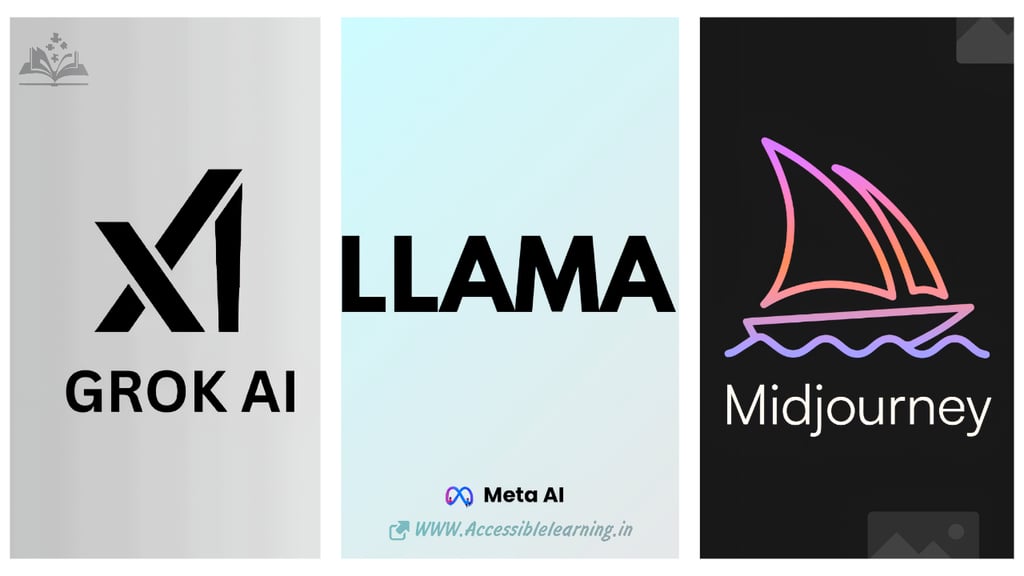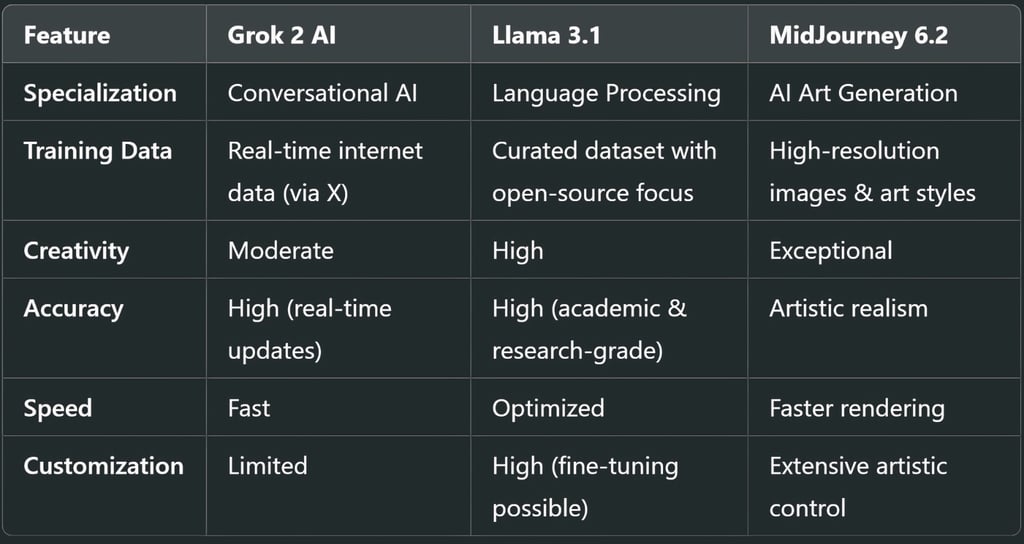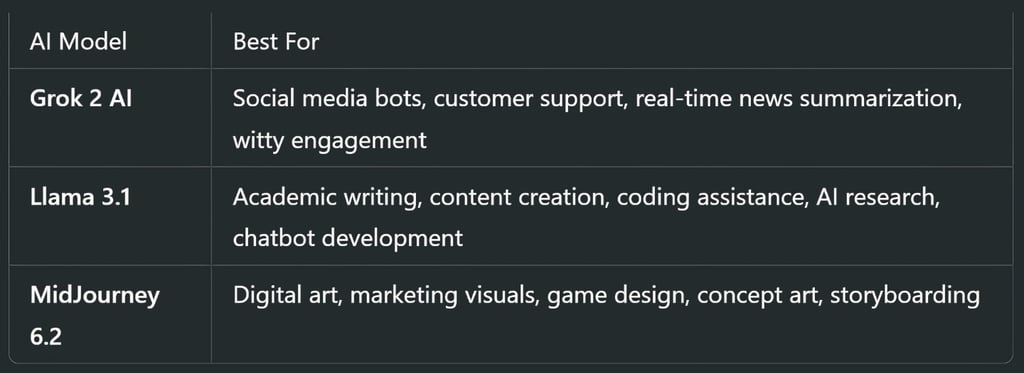
Grok 2 AI vs Llama 3.1 vs MidJourney 6.2 – Features, Performance & Future Potential
Grok 2 AI vs Llama 3.1 vs MidJourney 6.2 – A deep dive into the latest advancements in conversational AI, open-source language models, and AI-generated art. Compare their features, performance, and future potential to find the best AI for your needs.
AI ASSISTANTAI/FUTURECOMPANY/INDUSTRYEDITOR/TOOLS
Sachin K Chaurasiya
3/16/20255 min read


Artificial intelligence is evolving rapidly, with companies continuously pushing the boundaries of innovation. Grok 2 AI, Llama 3.1, and MidJourney 6.2 are three of the most talked-about AI models in their respective domains. But how do they compare, and which one is best suited for your needs? Let's dive into an in-depth analysis of these AI powerhouses.
Understanding the Competitors
Before we compare them, let's understand what each AI model specializes in.
Grok 2 AI: Developed by xAI, the AI venture founded by Elon Musk, Grok 2 is an advanced conversational AI designed to rival OpenAI’s ChatGPT and Anthropic’s Claude. It focuses on real-time information processing, witty interactions, and contextual understanding. Unlike some models that rely solely on pre-trained datasets, Grok 2 can fetch live data from X (formerly Twitter), making it more current in conversations.
Llama 3.1: Meta’s Llama (Large Language Model Meta AI) has been making waves in the open-source AI community. Llama 3.1 continues the trend of being a powerful, efficient, and customizable language model, primarily aimed at researchers and developers seeking a transparent AI alternative. Unlike its predecessors, Llama 3.1 features improved token efficiency and more human-like text generation, making it a strong competitor in the LLM space.
MidJourney 6.2: While Grok 2 and Llama 3.1 excel in text-based AI, MidJourney 6.2 dominates the AI image generation space. With each iteration, MidJourney refines its artistic capabilities, offering highly realistic and creative visuals. Version 6.2 brings improved lighting effects, better anatomical accuracy in human figures, and more stylistic customization for users.
Now, let’s compare these models based on performance, features, use cases, accessibility, and future potential.
Performance & Capabilities
Key Takeaways
Grok 2 AI is best for those seeking conversational AI that blends real-time data with humor and wit.
Llama 3.1 is ideal for researchers and developers who require a powerful, adaptable language model.
MidJourney 6.2 is perfect for designers, artists, and anyone needing top-tier AI-generated images.


Features & Functionality
Grok 2 AI: Real-Time Conversational Brilliance
Integration with X (formerly Twitter) for real-time data.
Strong reasoning capabilities and contextual understanding.
Engaging, witty, and informative responses tailored for social interaction.
Developer-friendly APIs for chatbot integration.
Limited customization options compared to open-source models like Llama 3.1.
Llama 3.1: Open-Source Powerhouse
Highly optimized for efficiency in language modeling, reducing computational costs.
Open-source access allows customization and fine-tuning for niche applications.
Strong multilingual capabilities and superior contextual comprehension.
Balanced between reasoning, creativity, and factual accuracy.
Enhanced security and privacy for enterprises using self-hosted models.
MidJourney 6.2: The Art Maestro
Enhanced realism in AI-generated images with better texture detailing.
More refined control over facial expressions, lighting, and composition.
Faster generation speed compared to previous versions.
Competitive with DALL·E, Adobe Firefly, and Stable Diffusion XL.
New feature: Multi-step refinements allow artists to iteratively adjust elements in an image without full regeneration.
Use Cases & Applications
Which AI Should You Choose?
Need a chatbot with real-time updates? → Grok 2 AI
Looking for an open-source language model? → Llama 3.1
Want stunning AI-generated visuals? → MidJourney 6.2




Future Potential & Roadmap
Grok 2 AI
Plans to integrate deeper with X’s ecosystem, providing AI-driven recommendations and analytics.
Potential expansion into multi-modal capabilities (image + text generation).
AI agents for task automation and knowledge retrieval.
Llama 3.1
Future iterations may include better real-world reasoning, competing directly with GPT-4 and Claude.
More optimization for mobile and edge computing applications.
Expansion of community-driven tools and plug-ins for enhanced functionality.
MidJourney 6.2
Enhanced motion graphics support for AI-generated animations.
AI-assisted 3D modeling for game developers and digital artists.
Integration with VR/AR applications for next-gen creative experiences.
Frequently Asked Questions
What is the main difference between Grok 2 AI, Llama 3.1, and MidJourney 6.2?
Grok 2 AI specializes in real-time conversational AI with internet-connected responses.
Llama 3.1 is an open-source language model designed for researchers, developers, and enterprises.
MidJourney 6.2 is an AI image-generation model that produces highly realistic and creative visuals.
Which AI model is best for content creation?
Llama 3.1 is ideal for writing long-form content, research papers, and chatbot development.
Grok 2 AI works well for social media engagement and real-time discussions.
MidJourney 6.2 is best for generating artistic content like illustrations and marketing visuals.
Is Grok 2 AI better than Llama 3.1 for chatbots?
Grok 2 AI is superior in real-time engagement since it fetches live data from X (formerly Twitter).
Llama 3.1 is better for offline chatbot applications where customization and fine-tuning are needed.
Does MidJourney 6.2 support text generation like the other two models?
No, MidJourney 6.2 is solely focused on AI-generated images and artwork. It does not support text-based outputs like Grok 2 AI or Llama 3.1.
Which AI model is open-source?
Llama 3.1 is the only fully open-source model, allowing developers to fine-tune and modify it as needed. Grok 2 AI and MidJourney 6.2 are proprietary models.
Can I use these AI models for free?
Grok 2 AI offers a limited free tier on X, with premium features requiring a subscription.
Llama 3.1 is completely free and open source for anyone to use.
MidJourney 6.2 does not have a free tier; it requires a paid subscription to generate images.
Which AI model is best for developers and businesses?
Llama 3.1 is best for businesses and developers needing a customizable, open-source AI model.
Grok 2 AI is useful for brands focused on social media interactions and real-time data-driven chatbots.
MidJourney 6.2 is ideal for businesses in design, marketing, and content creation.
What are the future updates expected for these AI models?
Grok 2 AI may integrate multi-modal capabilities (text + image generation) and expand real-time analytics.
Llama 3.1 is expected to enhance reasoning abilities and improve efficiency in enterprise AI applications.
MidJourney 6.2 could introduce 3D modeling, motion graphics, and VR/AR integrations.
Each AI model excels in its domain. If you need a real-time conversational AI, Grok 2 AI is a solid choice. If you prefer an open-source, adaptable language model, Llama 3.1 is the best fit. And if you are into AI-powered art generation, MidJourney 6.2 is unparalleled.
The best AI model for you depends on your needs, whether it's content generation, research, or creative visuals. As AI continues to evolve, we can expect even more powerful and refined versions of these models in the future.
Which AI are you most excited to use? Let us know in the comments!
Subscribe To Our Newsletter
All © Copyright reserved by Accessible-Learning Hub
| Terms & Conditions
Knowledge is power. Learn with Us. 📚


